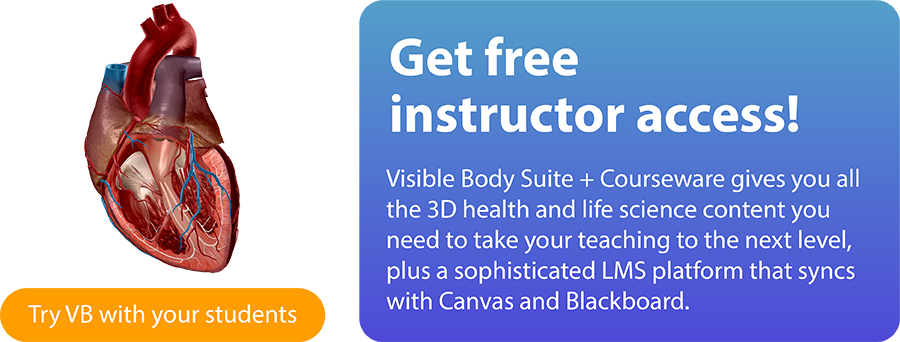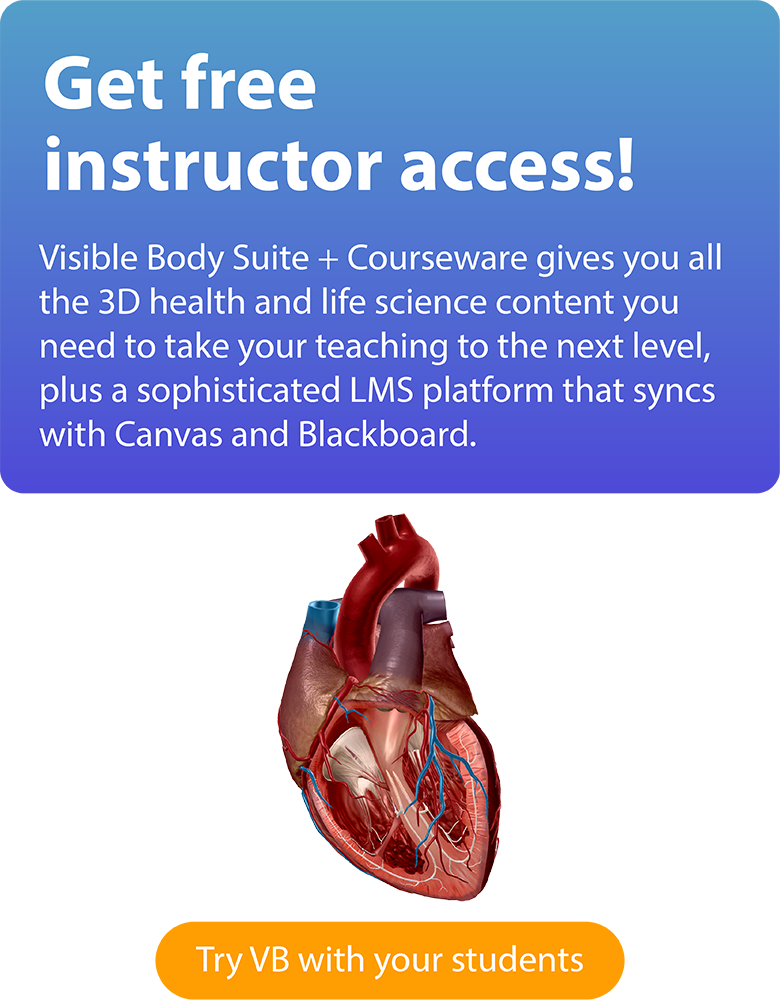Posted on 8/29/25 by Sarah Boudreau
Visible Body’s 3D renal anatomy models help students visualize kidney anatomy, physiology, and pathologies. In this blog post, we’ll look at the engaging content instructors can use in their classrooms with Visible Body Courseware.
Courseware is Visible Body’s teaching and learning platform that leverages Visible Body Suite’s comprehensive library of 3D and 2D life sciences content. Visible Body’s models, tools, and features are all designed to break down challenging concepts into bite-sized pieces.


To understand kidney pathologies, students first need to master kidney anatomy and function.
With premade assignments in Visible Body Courseware, instructors can save time and energy on prep, while students explore anatomy in engaging 3D. Assignments in Courseware create an “on rails” experience, in which students move through a sequence of 3D views, animations, histology slides, and/or quizzes. Instructions accompany each activity to keep students on task. Meanwhile, manipulating the 3D models encourages curiosity and self-driven learning.

GIF from the "Kidney Anatomy and Physiology" premade assignment in Courseware.
In Visible Body’s premade course Anatomy and Physiology: Essential Concepts, instructors can find an entire folder of assignments that cover the urinary system, kidney anatomy, urine production, and urine storage and elimination, culminating in a unit quiz. Users can also find virtual lab assignments that cover nephrons, glomerular filtration, and urine production.
Got the basics covered? It’s time to look at pathology models!
In VB Suite, the kidney stone pathology model provides a breakdown of how kidney stones form, as well as their passage and obstruction. View the kidney stones forming in the renal calyces, follow their path to the bladder, and observe how they can obstruct the urinary tract.

Kidney stone model in VB Suite, available with Courseware.
With VB Suite's 3D pathology model of polycystic kidney disease, students can better visualize the cysts that interfere with kidney function. Through the info box, students can learn how and where the cysts form and how they damage renal tissue.

Polycystic kidney disease model in VB Suite, available with Courseware.
The most common cause of acute kidney injury is acute tubular necrosis—and we’ve got a model for that! The acute tubular necrosis model shows necrotic lesions forming on the tubules, interfering with the nephron’s ability to filter the blood.

Acute tubular necrosis model in VB Suite, available with Courseware.
There are three forms of acute kidney injury: prerenal, intrarenal, and postrenal. To illustrate these different forms, instructors can use the kidney, nephron, and simplified nephron models, combined with VB Suite’s annotation tools.
 Nephron model in VB Suite, available with Courseware.
Nephron model in VB Suite, available with Courseware.
In VB Suite, instructors and students can use models like a 3D canvas, adding drawings, arrows, notes, and other annotations. For example, instructors can draw lines as they lecture to represent reduced renal perfusion and reduced pressure in the kidney.
The tools we’ve talked about in the previous section can be used to teach chronic kidney disease as well, so instead, let’s look at other models that can bolster students’ understanding of chronic kidney disease.
High blood pressure and diabetes are the most common causes of chronic kidney disease. To walk students through these conditions, you can use the following:

Interactive beating heart model in VB Suite, available with Courseware.
After investigating these related models and animations, students will better understand chronic kidney disease as well as how body systems interconnect.
Want to learn more about teaching renal anatomy with Visible Body? Check out this lesson plan on renal system anatomy developed by Dr. Cindy Harley of Metropolitan State University that includes pre-class homework, in-class activities, and assessment.
Happy teaching!
Be sure to subscribe to the Visible Body Blog for more awesomeness!
Are you an instructor? We have award-winning 3D products and resources for your anatomy and physiology course! Learn more here.
When you select "Subscribe" you will start receiving our email newsletter. Use the links at the bottom of any email to manage the type of emails you receive or to unsubscribe. See our privacy policy for additional details.
©2025 Visible Body, a division of Cengage Learning